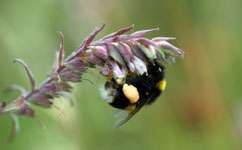Pesticides hit bumblebee reproduction

Scientists already knew that neonicotinoid pesticides, which affect insects' nervous systems, can alter bee behaviour, putting these vital pollinators, already threatened by habitat loss and disease, further at risk.
This new piece of research shows that bumblebees with diets contaminated with levels of neonicotinoid pesticide typically found in the environment produce up to a third fewer offspring.
The scientists looked at other ways that neonicotinoids could have affected reproduction. They found the pesticides do not damage the development of ovaries or delay egg-laying, except at really high doses. But they noticed that the more pesticide a bumblebee ingested, the less pollen and syrup it ate. So exposed bees may not have had the nutrients needed to lay the normal number of eggs in the first place.
"There could be two reasons why they're feeding less," suggests Ian Laycock from the University of Exeter, whose research was published in Ecotoxicology last month. "They could be learning to avoid the food but we don't think this is the case, because the drop in feeding rates becomes more intense over time. We think there's a toxic effect altering their ability to feed. At higher exposures of the pesticide their movement is compromised, and the efficiency of their foraging is reduced."
This adds to a growing body of evidence that neonicotinoids alter bee behaviour and may affect bee populations. Studies published in Science in March this year showed that pesticide exposure below the lethal dose damages bees' normally good sense of direction. Bees were not only getting lost and dying outside the hive more often, but also bringing home less food being, leading to dramatic reductions in the number of queens being produced.
"In these more recent studies, people are starting to take account of the actual doses bees are likely to get," explains Laycock. 'The newer research is a lot more environmentally realistic, so it's attracting a lot more attention. They're coming up with very interesting evidence, such as the effect of pesticide exposure on the production of queens.'
"But we need more information before we can definitely say that pesticides are causing a decline," Laycock adds. "So far, we know that it harms the bees, but there are still so many questions, such as whether the queens can recover."
Neonicotinoid pesticides are not the only problem that bees face. The varroa mite, a bloodsucking parasite that lives on bees, has spread rapidly around the world in the last 50 years. It increases the transmission of a deadly virus to levels capable of wiping out whole colonies.
This threat is amplified by the reduction of habitat. The UK has lost most of its wildflower meadows, dramatically reducing the food sources available to bees, butterflies and moths. Add the threat of behaviour-altering pesticides to both kept and wild bee populations, and it's clear that pollinators are in for a rough time.
These threatened pollinators are essential to agriculture. French and German scientists valued the pollination service provided by insect pollinators at 153 billion euros, amounting to 9.5 per cent of total farm production.
"Bumblebees are increasingly important in agricultural pollination," says Laycock. "There are some crops, particularly fruit crops, where bumblebees are particularly good at pollination. Also, they're pretty much intrinsic to maintaining wildflower populations, so we also have to think about biodiversity."
The scientists now hope to look at whether the bumblebees can recover from the short pulses of the neonicotinoid pesticide released into the environment in the spring.
"In the UK, roughly 85 per cent of [the neonicotinoid] imidacloprid is used growing oilseed rape, so the bees are getting exposed in short bursts during the mass flowering," Laycock explains. "It's hitting them when they're building a workforce big enough to support the production of queens. If they can't build this workforce they could be vulnerable, so we need to answer the question on whether they can recover from that."
More information: Ian Laycock, et al., 2012. Effects of imidacloprid, a neonicotinoid pesticide, on reproduction in worker bumble bees. Ecotoxicoloy
Journal information: Science
Provided by PlanetEarth Online
This story is republished courtesy of , a free, companion website to the award-winning magazine Planet Earth published and funded by the Natural Environment Research Council (NERC).

















